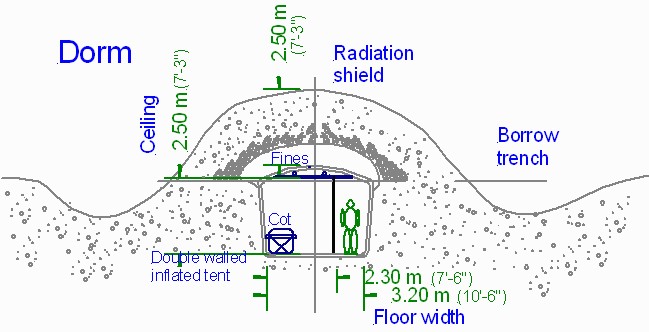Difference between revisions of "Roof Support"
(→Pressure Considerations: Added regolith support thickneses) |
|||
| Line 1: | Line 1: | ||
| − | |||
| − | |||
[[Image:ArchDorm01.jpg|frame| Architecture as Mole Hills, Standard dorm room]] | [[Image:ArchDorm01.jpg|frame| Architecture as Mole Hills, Standard dorm room]] | ||
<BR clear="all"/> | <BR clear="all"/> | ||
| Line 36: | Line 34: | ||
Here are some of present ideas for lunar settlement air pressures: | Here are some of present ideas for lunar settlement air pressures: | ||
| + | |||
{| border=1 | {| border=1 | ||
| Line 62: | Line 61: | ||
It is important to note that the internal pressure inside a living area has plenty of force to support a substantial thickness of lunar regolith above it for radiation and thermal shielding even if low pressures are used. | It is important to note that the internal pressure inside a living area has plenty of force to support a substantial thickness of lunar regolith above it for radiation and thermal shielding even if low pressures are used. | ||
| − | |||
| − | |||
| − | |||
==Safety rule== | ==Safety rule== | ||
Revision as of 10:10, 18 September 2007
One serious lunar problem will be your roof falling in on you.
Using the roof for radiation shielding
The need for radiation shielding for lunar settlement occupants means that there will be significant mass on the roof of all buildings used for long term occupancy. Much of the electronic equipment will need shielding too. This shielding could be in the form of lunar regolith as suggested in Architecture as Mole Hills and Architecture as Tent City or material brought from Earth, but it must be provided.
Also, if your massive roof falls in on you, you will be in real trouble.
Inflatable housing
Since the interior living space must be at considerably higher air pressure than the exterior, it is only logical to use the force this pressure exerts on the outside walls to help support the weight of the roof. The rooms then become like balloons getting much of their strength from their internal pressure. The amount of mass an inflated roof will support is directly related to the internal pressure.
A major problem comes when you lose the pressure and the massive roof falls in on you. Loss of pressure, or blow out, is a real possibility due to meteorites, ejecta, landing accidents, or industrial accidents. Even if you can get into an environmental suit, you will have to get to safety before your air supply runs out.
Pressure Considerations
One of the most important considerations in the design of a lunar settlement will be the internal air pressure.
High air pressure makes the living space more Earth like. People and plants accommodate easily and food is easy to cook. But, spacesuits must be at low pressure for the joints to work with acceptable amounts of efforts. For the body to accommodate from normal air pressure to low spacesuit pressure can talk as long as three hours.
Low air pressure, with adequate oxygen content, allows accommodation to spacesuits in only a few minutes. But, water boils at such a low temperature that cooking is difficult and the long term health effects are not fully known for people or plants. Also low air pressure will not support as thick a layer of regolith over inflated buildings.
Here are some of present ideas for lunar settlement air pressures:
| Pressure | Pressure | Boiling Point | Regolith | Comment |
|---|---|---|---|---|
| kPascal | PSI | C | Meters | |
| 101.3 | 14.2 | 100 | 32 | Earth standard, ISS body |
| 84 | 12.17 | ? | 27 | Denver, a high altitude city |
| 74.0 | 10.2 | ? | 24 | Open airplane, ISS ports |
| 59.1 | 8.3 | ? | 19 | ISS spacesuit |
| 33.5 | 4.7 | ? | 10 | Apollo spacesuit |
| 30.6 | 4.3 | ? | 9.9 | Shuttle spacesuit |
| 26.0 | 3.65 | 69.0 | Top of Mount Everest |
It is important to note that the internal pressure inside a living area has plenty of force to support a substantial thickness of lunar regolith above it for radiation and thermal shielding even if low pressures are used.
Safety rule
The roof cave in problem will require a strong safety rule that will greatly affect the design of lunar buildings. One possible rule is this:
- Roof Support Rule
- With the internal building pressure completely lost, a person wearing an environmental suit must have enough clearance to crawl to safety even if a second person is lying immobile in the evacuation path.
Rule's effects
Such a rule, combined with the very high cost of bringing mass from Earth, will make large open rooms very rare on the Moon. Rooms and even halls will require internal columns or bearing walls to hold up the roof with a loose of pressure. Most rooms will have to be narrow in at least one direction and will have to have central support for the roof.
What will be very difficult to build will be very large areas such as meeting rooms and mess halls. They will probably need internal supports.
The absence of large rooms will make living in a lunar settlement even more claustrophobic. This effect might be countered with panoramic vistas of open space on external monitors, via pariscope style windows, or with viewing doom rooms.
| Hazards |
|---|







